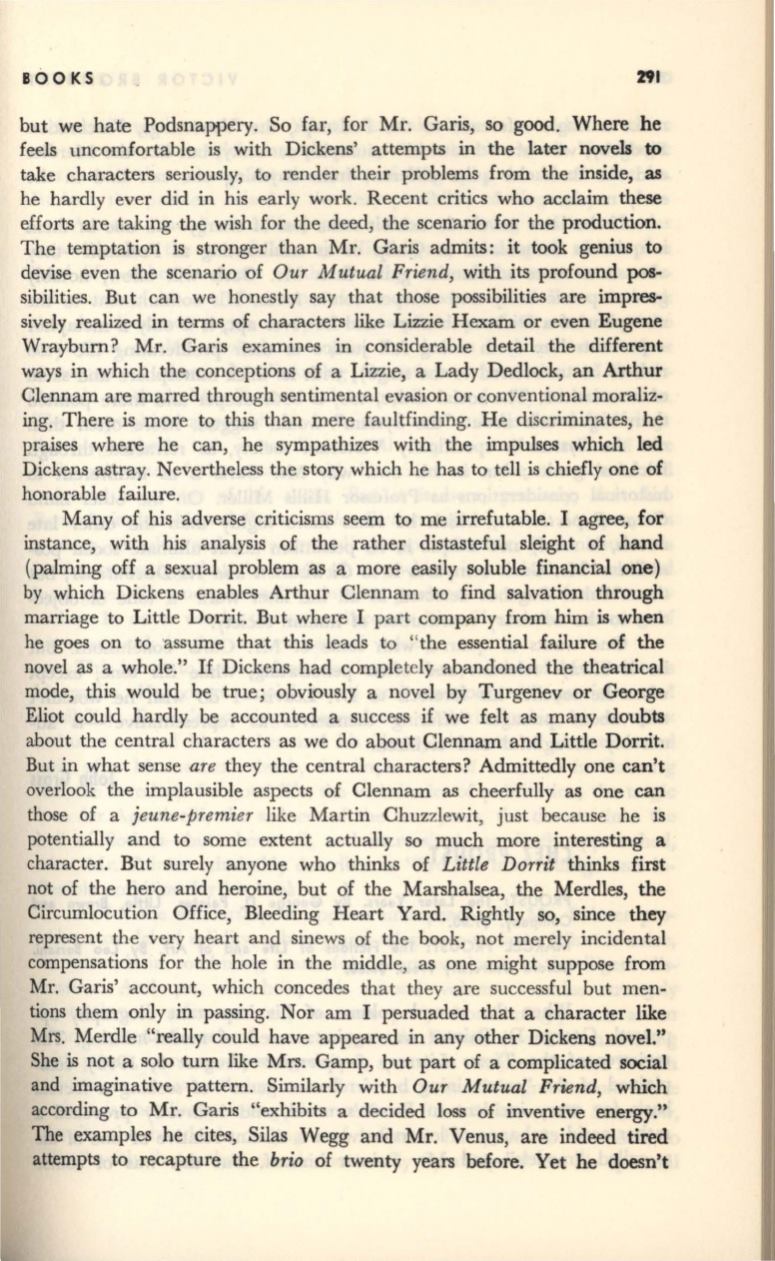
BOO KS
291
but we hate Podsnappery. So far, for Mr. Garis, so good. Where he
feels uncomfortable is with Dickens' attempts in the later novels
to
take characters seriously, to render their problems from the inside, as
he hardly ever did in his early work. Recent critics who acclaim these
efforts are taking the wish for the deed, the scenario for the production.
The temptation is stronger than Mr. Garis admits: it took genius to
devise even the scenario of
OUT Mutual Friend,
with its profound
pos–
sibilities. But can we honestly say that those possibilities are impres–
sively realized in tenns of characters like Lizzie Hexam or even Eugene
Wrayburn? Mr. Garis examines in considerable detail the different
ways in which the conceptions of a Lizzie, a Lady Dedlock, an Arthur
Clennam are marred through sentimental evasion or conventional moraliz–
ing. There is more to this than mere faultfinding. He discriminates, he
praises where he can, he sympathizes with the impulses which led
Dickens astray. Nevertheless the story which he has to tell is chiefly one of
honorable failure.
Many of his adverse criticisms seem to me irrefutable. I agree, for
instance, with his analysis of the rather distasteful sleight of hand
(palming off a sexual problem as a more easily soluble financial one)
by which Dickens enables Arthur Clennam to find salvation through
marriage to Little Dorrit. But where I part company from him is when
he goes on to 'assume that this leads
to
" the essential failure of the
novel as a whole."
If
Dickens had completely abandoned the theatrical
mode, this would be true; obviously a novel by Turgenev or George
Eliot could hardly be accounted a success if we felt as many doubts
about the central characters as we do about Clennam and Little Dorrit.
But in what sense
are
they the central characters? Admittedly one can't
overlook the implausible aspects of Clennam as cheerfully as one can
those of a
jeune-premier
like Martin Chuzzlewit, just because he is
potentially and to some extent actually so much more interesting a
character. But surely anyone who thinks of
Little Dorrit
thinks first
not of the hero and heroine, but of the Marshalsea, the Merdles, the
Circumlocution Office, Bleeding Heart Yard. Rightly so, since
they
represent the very heart and sinews of the book, not merely incidental
compensations for the hole in the middle, as one might suppose from
Mr. Garis' account, which concedes that they are successful but men–
tions them only in passing. Nor am I persuaded that a character like
Mrs. Merdle "really could have appeared in any other Dickens novel."
She is not a solo tum like Mrs. Gamp, but part of a complicated social
and imaginative pattern. Similarly with
Our Mutual Friend,
which
according to Mr. Garis "exhibits a decided loss of inventive energy."
The examples he cites, Silas Wegg and Mr. Venus, are indeed tired
attempts to recapture the
brio
of twenty years before. Yet he doesn't


